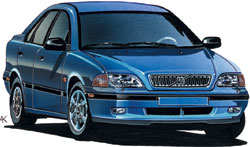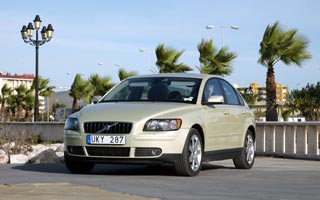Test drive Volvo S40 2000 - 2004 sedan
The price of extraordinary
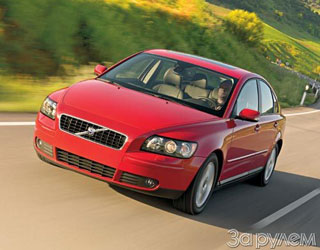 Whatever the optimists say there, life does not become easier with the development of technology. Especially for those who create new cars. Today, every self -respecting manufacturer strives in the premium segment, where not only prices, but also customer requirements are higher. Making cars for everyone in Europe seems to have become unprofitable.
Whatever the optimists say there, life does not become easier with the development of technology. Especially for those who create new cars. Today, every self -respecting manufacturer strives in the premium segment, where not only prices, but also customer requirements are higher. Making cars for everyone in Europe seems to have become unprofitable. Volvo all the more cannot afford ordinaryness. The S40 family with a release program of 70 thousand pieces per year should take a strictly defined niche, slightly squeeze competitors and win the sympathies of new customers. The loyal brand of the client is much more profitable than the one who, having left a couple of years on Volvo, will move to the competitor. And since the new S40 is aimed at the youngest and active part of the customers, he simply must convince them of the relevance of Swedish values. But so far, Volvo shows only pre -production machines - the refinement is not finished yet.
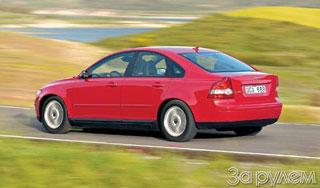 Less but more spacious
Less but more spacious The idea of \u200b\u200bthe Volvo S40 is quite simple - a compact car with a dynamic appearance, which is not inferior in comfort for a larger S60 and S80, but more affordable and aimed at the pleasure of driving. What does compact mean? Volvo S40 is 350 mm shorter than the flagship S80, moreover, 48 mm shorter than its predecessor. However, it is too early to say that the new S40 has become smaller. The wheelbase of the machine increased by 78 mm, an over average by 60, a width of 54, and a height by 44 mm. So in the internal dimensions, it significantly exceeds the machine that it replaces. Both in front and behind enough space for a person is noticeably higher than average height, the only restriction - two of a meter of ninety should not sit down one after another, it is worth choosing even more tall configuration without a hatch.
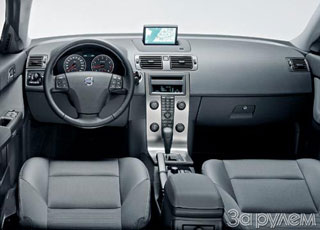 Security first of all
Security first of all The desire to preserve the life of passengers has always been a strong feature of Volvo. But to provide protection in a compact car as in a large car is very difficult - too small zones of deformation. In order to effectively dispel the energy of the collision and keep the salon intact, over the 40th I had to work hard. In the design of the S40 body, four types of steel with different characteristics of strength are used. The hood, wings and external parts are deformed quite easily, contributing to a reduction in risk when hitting a pedestrian, a collision with a cyclist or motorcyclist. However, the economic question is not forgotten - the price of car restoration after a slight collision. In the fastening of the front bumper, Crash boxes are used - deformable elements that are easy and relatively inexpensive to replace. Even the layout of the motor compartment was thought out so that, with a frontal collision, let the transverse engine move 150 mm before the block rows into the hard elements of the body. And thanks to the compactness of the transverse five, it was possible to find 70 mm of the gap between the valve cover and the hood - this is already for the sake of passive safety of others.
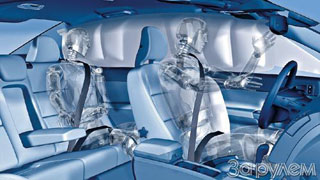 Caring for the strength and optimal design of the body positively affected not only safety - compared to the previous S40, the hardness of the body torsion increased by 68%, which promises to simplify the work of engineers bringing the chassis.
Caring for the strength and optimal design of the body positively affected not only safety - compared to the previous S40, the hardness of the body torsion increased by 68%, which promises to simplify the work of engineers bringing the chassis. Of course, traditional measures are not forgotten - inertial safety belts with pretense and restriction of effort, two -stage front safety pillows and a branded Volvian curtain to protect the driver’s head and passenger with a side impact or overturning. Of the non -traditional ones, the special design of the headrests and backs of the front seats (Whiplash Protection System), which reduces the likelihood of injury when hitting the back, and the alarmist of non -set belts in the rear seat.
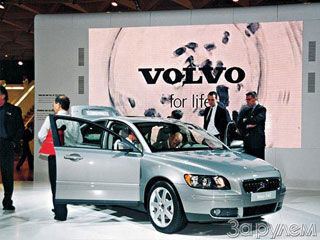 However, the genuine find of the new Volvo is called IDIS (Intelligent Driver Information System - the intellectual system of informing the driver). Its task is to protect the driver from excess information in tense conditions and focus on the most necessary actions at the moment. In practice, this means that IDIS analyzes the driver’s actions. Pressing on the gas and brake pedal, rotation of the steering wheel, turning on the turning indicator - everything is taken into account in the aggregate, and if IDIS finds the control active, then blocks the navigator and communication system, which is based on the mobile phone. That is, he will not call the fork or when overtaking. This is the standard equipment of all Volvo-S40.
However, the genuine find of the new Volvo is called IDIS (Intelligent Driver Information System - the intellectual system of informing the driver). Its task is to protect the driver from excess information in tense conditions and focus on the most necessary actions at the moment. In practice, this means that IDIS analyzes the driver’s actions. Pressing on the gas and brake pedal, rotation of the steering wheel, turning on the turning indicator - everything is taken into account in the aggregate, and if IDIS finds the control active, then blocks the navigator and communication system, which is based on the mobile phone. That is, he will not call the fork or when overtaking. This is the standard equipment of all Volvo-S40. 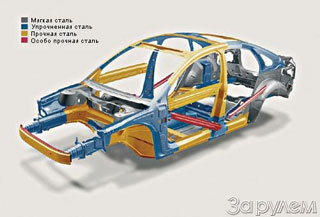 We are looking for a highlight
We are looking for a highlight The original appearance is an undoubted plus, especially if it is not burdened with extravagance. The Volvo S40 has all the family features of the new face of the brand: a rounded front sight, a protruding grill, grown with a bumper, characteristic shoulders of the sidewalls, original rear lights.
But in search of the most unusual detail, you should look inside. The interior of a car saturated with electronics is involuntarily built around the central console, and its appearance determines the impression of the machine. The S40 panel curved with a wave is divided into two zones - a phone with an audio system and a climatic installation, combining the central part with buttons and four round selectors similar to the old -fashioned settings
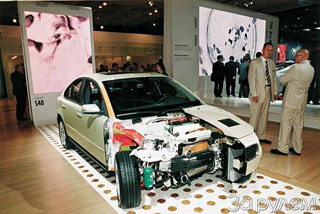 receiver. There are no indicators on the console itself - a single display is located immediately under ventilation deflectors. But the most curious is not that and not even that the panel is thin, and behind it is an additional compartment for small things. It is much more interesting that, in addition to finishing with plastic, wood or aluminum, the panel can be ... transparent, opening the look of its electronic filling.
receiver. There are no indicators on the console itself - a single display is located immediately under ventilation deflectors. But the most curious is not that and not even that the panel is thin, and behind it is an additional compartment for small things. It is much more interesting that, in addition to finishing with plastic, wood or aluminum, the panel can be ... transparent, opening the look of its electronic filling. In the world of engines
Under the hood of Volvo S40, a modest selection of units. All gasoline engines are located across in -line fives with a volume of 2.4 and 2.5 liters with four valves on the cylinder and adjustable gas distribution phases. Smaller - hopeless, with a capacity of 103 kW/140 liters. With. and 125 kW/170 l. With. These are almost the same engines that differ only in filling in injection and gas distribution. The less powerful is equipped with a gearbox with stretched ranges and a longer main pair for a calm and economical driving, the other, respectively, is sharpened on an active driver. The most serious motor is 2.5 liters with a low -pressure turbocharger develops 162 kW/220 liters. p., it will be proposed with a mechanical six -speed box, and later for an all -wheel drive modification that allows you to realize its capabilities in difficult conditions. It is curious that engines of a fairly large volume - this should guarantee good acceleration dynamics in the entire speed range. After all, the main Volvo market is American.
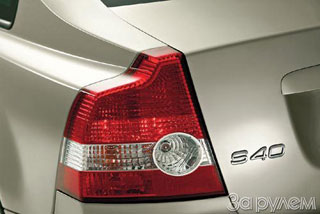 Diesel engines with a volume of 2 and 1.6 liters with a turbocharged and injection system Ustmon Rail are designed for European models and developed jointly by Ford and Peugeot. However, we will see a small diesel only a year later. Then, under the hood, Volvo will receive a registration and a 1.6-liter gasoline engine. An intermediate 1.8-liter gasoline four will become available in April. These models will be cheaper than five-cylinder Volvo-S40, the base price of which in Europe is expected at the level of 20 thousand euros.
Diesel engines with a volume of 2 and 1.6 liters with a turbocharged and injection system Ustmon Rail are designed for European models and developed jointly by Ford and Peugeot. However, we will see a small diesel only a year later. Then, under the hood, Volvo will receive a registration and a 1.6-liter gasoline engine. An intermediate 1.8-liter gasoline four will become available in April. These models will be cheaper than five-cylinder Volvo-S40, the base price of which in Europe is expected at the level of 20 thousand euros. The Russian market for Volvo is far from the last. Of course, it cannot be compared with the American one, where the company plans to sell 20 thousand S40 per year, or with his native Swedish, where 5,000 cars were sold. But with a favorable set of circumstances, Russia may well fall into the first ten importers. Moreover, the Volvo markets are traditionally divided into sred and universal. For example, in Germany, almost exclusively Swedish station wagons are sold, and in the USA - mostly sedans. Russia is also traditionally a country of sedanov, and therefore the prospects of Volvo S40 are not bad. As far as the expectations and real impressions of the new car coincided, we will tell after the test drive.
Anatoly Fomin. Photo by the author and company Volvo
Source: The magazine "Driving"








